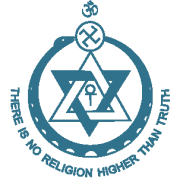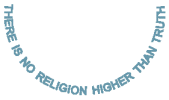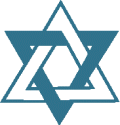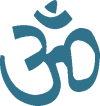

The Emblem of the Theosophical Society is composed of a number of symbols, all of which have been used from very ancient times to express profound spiritual and philosophical concepts about the human being and the universe. They are found in a variety of forms in the great religions of the world and their universality is further shown by their appearance in widely separated cultures. Each symbol studied separately will yield a wealth of understanding. Taken together, as in this emblem, they suggest a vast evolutionary process embracing the whole of nature, physical and spiritual and their study may lead the serious inquirer to contemplate some of the deepest mysteries of existence.
Partly because of their antiquity and partly because of the difficulty of establishing their origin, the symbols cannot be interpreted with a narrow precision. The interpretation here offered is to be taken as suggestive of the truths they seek to convey rather than as an exact statement of their meaning.


The Motto: Surrounding the emblem runs the motto of The Theosophical Society, 'There is no Religion Higher than Truth.' Truth is the quest of every Theosophist, whatever their faith, and every great religion reflects in some measure the light of the one eternal and spiritual Wisdom. More ...


The Ankh: In the centre of the two interlaced Triangles is what is known as the Ankh (or the Crux Ansata). This comprises a circle surmounting the Tau Cross (the type of cross which follows the shape of the letter 'T'). The Ankh is an Egyptian symbol of great antiquity and it portrays the resurrection of the spirit out of its encasement of matter, otherwise expressed as the triumph of life over death, of spirit over matter, of good over evil. This concept of the 'Resurrection' is found in all the great religions.


The Interlaced Triangles: These are often called the Double Triangle, viewed by the Jewish Kabalists as the Seal of Solomon and also known as Sri Yantra and Satkona Chakram in the Indian tradition. They are surrounded by a serpent. This combination of the triangle and the surrounding serpent symbolizes the created universe, through which creation is limited in time and space.
The Triangles, looked at separately, symbolize the three facets of the manifestation which is known as the Trinity in various religions and personified in Christianity as Father, Son and Holy Ghost and in Hinduism as Shiva, Vishnu,and Brahma. The darker of the two triangles, which is downward-pointing, and the lighter triangle, which is upward-pointing, symbolize respectively the descent of the life of Spirit into matter and the ascent of that life out of matter into Spirit, the perpetual opposition between the light and dark forces in nature and in man.


The Serpent: Apart from the significance of its surrounding the triangles as mentioned above, the serpent itself has always been a symbol of Wisdom. The Hindus call their wise men 'Nagas' (a word meaning serpent). Christ adjured His disciples to be as 'wise as serpents.' What is known as the Uraeus (or sacred Cobra) seen on the forehead of a Pharaoh of Egypt denoted his initiation into the sacred rites where knowledge was gained of the hidden Wisdom. The serpent swallowing its tail represents the 'circle of the universe', the endlessness of the cyclic process of manifestation.


The Swastika: This is another of the numerous forms in which the cross is found. It is the Fiery Cross, with arms of whirling flame revolving (clockwise) to represent the tremendous energies of nature incessantly creating and dissolving the forms through which the evolutionary process takes place.
In religions which recognize three aspects of Deity, the Swastika is associated with the third aspect, the Third Person of the Trinity, who is the Creator: Brahma in Hinduism and the Holy Ghost in Christianity.


The Aum: Surmounting the emblem is the sacred word Om of Hinduism in Sanskrit characters, the three letters representing the Trinity. There is also the idea of the creative Word or Logos sounding throughout, and sustaining, the universe. In the Prologue of the Gospel according to John, in the Holy Bible, we read: 'In the beginning was the Word, and the Word was with God, and the Word was God'. The emblem as a whole symbolizes the Absolute, God, both transcendent and immanent. God transcendent - that is, in and beyond creation - (the sacred word AUM) overshadows the cycle of manifestation (serpent), energized by divine activity (Swastika); and within this field of manifestation the linked triangles of spirit and matter enshrine the symbol of immortality (the Ankh), God immanent - that is, indwelling in all created forms.
We have given here only a slight indication of the great range and depth of meaning contained in the emblem of the Society. The study of its symbolism is almost inexhaustible. Those who wish to pursue this study in greater detail are referred to The Theosophical Seal by Arthur M. Coon or to The Secret Doctrine, by H.P. Blavatsky. The Hastings Dictionary of Religion and Ethics and some general encyclopedias also contain useful articles on symbolism in general and on particular symbols.
See also TS-Wiki